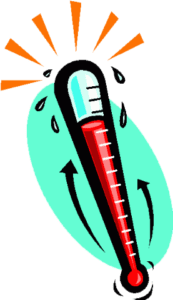Heatstroke in Dogs: Symptoms and First Aid

Hot weather can lead to heatstroke in dogs.
Over the years, We’ve treated dozens of cases of heatstroke in dogs. Sadly, it usually happens when a well-meaning pet lover simply makes an error in judgement, either by overlooking risks and exercising their dog despite dangerous conditions, or by delaying treatment after heatstroke begins. All to often, it turns out to be a deadly mistake.
Though it is treatable, heatstroke kills. Even with aggressive 24h hour care, a significant percentage of dogs with heatstroke die from the complications of their illness or are euthanized when the family’s financial resources are simply exhausted. Severe cases of heatstroke can result in ICU stays lasting more than a week and veterinary bills that exceed $10,000.
Symptoms of Heatstroke in Dogs
Heat-related illnesses in humans start with heat cramps, followed by heat exhaustion, and then heatstroke. Mild illness becomes a medical emergency somewhere between heat exhaustion and heatstroke. Dogs go through these stages too. The trouble is that the symptoms of less-serious heat cramps and heat exhaustion–headache, fatigue, lightheadedness, thirst, cramps, nausea– are easy to feel when they happen to you, but almost impossible to see when they happen to your dog. In a few hours or less, untreated heatstroke damages the brain, heart, kidneys, muscles and other organ systems. The longer treatment is delayed, the worse things get.
The symptoms of deadly heat stroke in dogs, on the other hand, are easy to spot:
- Incessant panting, restlessness
- Weakness, ataxia (wobbliness, difficulty walking)
- Drooling
- Vomiting
- Bright red, gray, purple, or bluish gums
- Collapse
- Seizures
- Bruising (first appears as pinpoint bruises that can be mistaken for a “rash”)
- Bloody diarrhea
First Aid for Heatstroke in Dogs
Cooling is critical. Too much cooling, however, can make things worse. The most important thing to do is to get your dog to the vet–any vet–quickly. If your family vet is more than a few minutes away, call and let them know you’re going to the nearest ER or ask for a referral to a colleague closer to home. This can’t wait, and we understand.
What to DO:
- Get your dog out of the sun, ideally into an air-conditioned home
- Lay your dog on a cool surface (tile flooring is great) and direct a fan on him or her
- Take and record rectal temperature
- Place cool, wet towels over the back of the neck, armpits, and groin areas; wet earflaps and paws with cool water
- Get to your vet or the local emergency veterinarian
What NOT to do:
- Don’t use cold water or ice. This causes the blood vessels in the skin to constrict, trapping heat in the body’s core, where it’s causing the most damage.
- Don’t overcool your dog. Once the rectal temperature drops to 103 F, stop the measures described above and get to the vet if you haven’t left already!
- Don’t force your dog to drink; it’s OK to have a bowl of fresh cool water available if your dog is interested in drinking on his or her own.
- Don’t leave your dog unattended for any length of time.
- Don’t take a “wait-and-see” approach. Dogs that are allowed to “sleep it off” are almost always worse in the morning
Veterinary Treatment for Heatstroke
Veterinary care for heatstroke starts with IV fluids, oxygen, treatment for shock, and drugs to control vomiting and other symptoms. Blood testing is used to identify complications like bleeding disorders, kidney failure, and other organ injuries. Some dogs need transfusions of plasma, treatment for brain swelling, control of seizures, and treatment of other complications. Most cases are hospitalized for the better part of a week.
Fortunately, heatstroke in dogs is preventable. Read our tips for avoiding this deadly disease.

